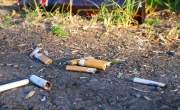Recycled glass identified as cement substitute in compressed earth blocks
The University of Portsmouth have identified the optimal ratio of powdered recycled glass in compressed earth blocks in a 28-day trial
 Researchers have found that adding recycled waste glass particles (RWGP) and lime to compressed earth blocks (CEB) improves their quality as a building material.
Researchers have found that adding recycled waste glass particles (RWGP) and lime to compressed earth blocks (CEB) improves their quality as a building material.
CEBs are made from a mixture of soil, sand and a stabilising agent, usually cement, compressed under high pressure. The study, published in Discover Civil Engineering, found that mixing recycled glass and lime with a significantly lower amount of cement improved the blocks’ strength and water resistance. Cement production accounts for approximately 8 per cent of total global CO2 emissions, and using the glass-lime mix would reduce the amount needed as a binding agent.
Compressed earth blocks are around 40 per cent cheaper than conventional bricks and concrete, due to their lower energy requirements. Conventional bricks are fired in a kiln, whereas CEBs are usually cured in the sun. A study estimates that eliminating the firing process through sun-drying can save six tonnes of CO2 for every 1,000 bricks produced. Producing a tonne of compressed earth blocks generates 22kg of CO2, instead of 200kg of CO2 for a tonne of conventional bricks.
Co-author, Dr Muhammad Ali, Associate Professor in Materials and Environmental Innovation at the University of Portsmouth’s School of Civil Engineering and Surveying, said: “There is an increased demand for the use of recycled industrial waste as sustainable building and construction materials so we wanted to assess the properties of compressed earth blocks using recycled glass particles.”
For this research waste glass was collected from a refuse dump in Kumasi, Ghana, crushed into smaller particles and sieved through a 2 mm British Standard sieve.
The team tested CEBs with mix ratios of RWGP of zero to 25 per cent, in five per cent intervals, mixed with a constant 10 per cent lime. Apart from determining the mechanical properties, the blocks were examined for microstructural characteristics using an electron microscope for 28 days.
Dr Ali added: “At each percentage level we tested for water absorption, how resistant to breaking the blocks were when compressed, and to determine the maximum stress the block could withstand while being stretched or pulled, before breaking or becoming deformed.”
The optimal mixture
The best-performing blend was found to be 10 per cent recycled glass with 10 per cent lime. These blocks achieved the highest compressive strength of 5.77 MPa (megapascal - a unit of pressure). This is compared with 3.03 MPa at 28 days of curing for the unstabilised earth blocks, representing a 90 per cent increase in compressive strength.
This best-performing blend also displayed the highest tensile strength at 0.52 MPa, while the unstabilised CEBs achieved 0.40 MPa at 28 days of curing, achieving a 30 per cent increase.
While a lower-concentration mix displayed the lowest rate of water absorption, the higher concentration achieved the greatest overall strength so the study still recommends the 10 per cent mix because it achieved the highest compressive and tensile strength.
Microscopic analysis revealed that this optimal mixture created a denser, more compact internal structure with no visible micro-cracks after 28 days. The fine glass particles of ground glass and lime filled gaps within the soil mixture, and the lime reacted with substances like silica and alumina in the glass and soil to form gels, such as Calcium-Silicate-Hydrates (C-S-H). This gel acts as a binder, sealing pores and strengthening the bonds between the material particles. The highest RWGP of 25 per cent mix exhibited micro-cracks in the blocks.
The University of Portsmouth, who partnered with the Akenten Appiah-Menka University in Ghana, London South Bank University and the Federal University of Technology in Nigeria and the CSIR-Forestry Research Institute of Ghana, suggests that future studies could further assess the thermal and durability properties of the greener construction materials.





